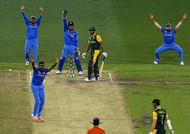Batting has been cricket’s glamour queen for a very long time. Fast bowling also hogged the limelight for some time with the rise of the invincible West Indian team. However, spin bowling has always been the perennial nerd in world cricket.
Appreciating a spin bowler takes the same amount of patience as fishing. To read a spinner’s mind, one needs to be endowed with the brain of a grandmaster. In short, spin bowling is a subtle art; a disenthrallment of necromancy.
An orthodox spinner cannot arride the ordinary fans nor can he incite profound palpitations. Spin bowling is a science that only nerds can comprehend. It has always lacked the rock star nature of fast bowling; picking up a wicket through spin might need an hour of scheming and several overs of setting-up.
Coming to the rescue of spin bowling were the mystery spinners, who at last brought the spectators to the edge of the seat every time they bowled. Their actions were bizarre, their grip not seen before in the history of the universe. The direction of spin often wandered into a cloud of confusion, putting Heisenberg’s principle of uncertainty to shame.
However, their decline has been as fast as their rise. They marched into world cricket like a meteoroid entering earth’s atmosphere, then disappeared completely after having fully burnt themselves.
In their short careers most of them shone bright, but failed to sustain their brilliance. Their inability to reinvent themselves clubbed with the cameras that leered at their actions and the analysts who dissected everything about them to the sub-atomic level contributed significantly to their demise.
ICC’s severity on chucking hasn’t helped them either. With Sunil Narine having already been reported, there are no more mystery spinners in world cricket who are effective. But that should stop us from exploring the possibilities of mystery spinners re-emerging into world cricket.
Who are mystery spinners?
Mystery spin cannot be termed as a third form of spin bowling alongside off spin and leg spin, since mystery spinners do not do anything off the pitch that either leg spinners or off spinners cannot. Most mystery spinners often spin the bowl both ways with a quirky action.
Sonny Ramadhin, the first mystery spinner from the West Indies, used his index finger to spin the ball from off to leg and his ring finger to spin the ball from leg to off. Ajantha Mendis, Jack Iverson, John Gleeson and Sunil Narine used their middle finger to flick the ball out of their hand while the direction of the spin depended on the position of their wrist.
However, care must be taken before pigeon-holing Muttiah Muralitharan, Saqlain Mushtaq, Saeed Ajmal or Ravichandran Ashwin as mystery spinners. That's because they were/are all orthodox spinners who had the ability to spin the ball “the other” way too.
Out of these spinners only Muralitharan can come close to the moniker ‘mystery spinner’ since he had a bizarre grip for an off spinner. But unlike the typical mystery spinners he relied more on pace variations, dip, drift and subtle deviations in line and length.
The tales of mystery spinners
Sonny Ramadhin was one of the very first mystery spinners with the ability to spin the ball both ways with very little change in action. But much like other mystery spinners who would succeed him, he faded away once batsmen found a way to work him out.
Jack Iverson made his debut in 1950 and immediately took the world by storm, spinning the ball using a quirky hold of the ball, in contrary to the then prevalent tradition of using either your fingers or the wrist to spin the ball. But an injury saw him draw the curtains on his career abruptly.
John Gleeson, a protégé of the Iverson way of spinning the ball, was tough to pick but was not as effective as the founder of his art. And Ajantha Mendis re-invented the lost craft in the second millennium, but he too like his predecessors faded away with time.
The possible reasons for their decline
One of the major reasons for their decline has been the over-exposure of their mystery. While most spinners can spin the ball both ways in ways that defy physics, the more orthodox bowlers have prolonged careers and can sustain their efficacy for a long time, while mystery men fade into oblivion almost as soon as they arrive.
Why? Because mystery spinners depend solely on spinning the ball both ways to confound the batsmen, while the orthodox spinners’ chief way of victimizing batsmen is through flight, drift, variation of pace and turn. The very ability to befuddle batsmen with spin in either direction itself turns out to be their nemesis.
Sonny Ramadhin, Ajantha Mendis and Jack Iverson all made headlines with their uncanny ability to run through a line up. Batsmen would sweat it out day and night to pick their variations, and the discovery of a way to handle them would ultimately spell their end.
Mystery spin, much like an overdose of antibiotics, quickly makes the adversary immune to it.
The other important factor is the inability of most mystery spinners to adopt the nuances of orthodox spin bowling. A good spinner with an element of mystery about him should still be able to be effective even if batsmen adopt a strategy to read the direction of his spin. But all mystery spinners vanished as soon as the batters could read which way the ball would spin.
The only possible reason for this observation is that the mystery spinners relied solely on their ability to dart the ball both ways. Once that is compromised, their life is lost.
When Ajantha Mendis shot to fame, he was thought to be an off spinner. Hence, batsmen were bamboozled by his carrom balls that went the other way. His first year in cricket was thus very successful, but the batsmen finally understood that he was a very different kind of spinner.
When they found a way to read his carrom balls, googlies and off breaks, his career was almost over. His inability to turn the ball big, drift the ball and change his pace to good effect proved to be his undoing.
Their incapability to re-invent themselves is another reason for their demise. When batsmen blocked their only way of picking up wickets, they could not emerge with a different option. Good players should always be able to circumvent challenges. But mystery spinners could not stand up to the challenge when it really mattered.
Can they rediscover their mojo?
The answer is a clear yes. And for an explanation to that answer, you need to look no further than Ravichandran Ashwin.
Ashwin is a quintessential spinner for most mystery spinners. The lanky Indian, despite being a very good off-spinner, initially made headlines for his carrom balls. With the overdose of T20s, Ashwin almost became a mystery man, often bowling his carrom balls every other ball. At one stage he stopped trying to spin, flight or drift the ball.
But towards the latter part of 2014, he rediscovered himself. The World Cup saw him vary his pace, flight the ball and spin it. He wanted to out-do the batsmen in the air instead of off the pitch. All of a sudden, an above-average-bowler became an unplayable nightmare.
His off breaks curled like a snake in the air and leapt like a frog off the pitch, so much so that Kumar Sangakkara, the best batsmen of the modern era, got out four times in a row to him. Batsmen knew what was coming at them but they still had no answer.
So much for mystery! While Ashwin still bowls his carrom balls, he seems to have clearly understood the fact that his primary weapon is his stock delivery.
Mystery spinners should all adopt a stock ball. It can be any ball, but they should bowl their variations around it. Bowling six different balls an over might initially bring success, but as history indicates, with time that would be their bête noir.
Variations are good only as long as they are used as variations. The moment variations rival the stock balls, the bowler should start counting his days.
“Playing in the mind” is a term that most good spinners love to use. Saeed Ajmal’s off breaks spun big. When he made his debut in 2009, he rattled the Lankans. But curse the ad nauseam of T20s, his doosras upstaged his off breaks as he somehow forgot the art of defeating the batsmen in the air. He was flat during the latter part of his career as he started losing his effectiveness before being banned for chucking.
Ashwin and Ajmal are two good examples for future spinners who want to have a touch of mystery about them. Ashwin – the example of how to be, and Ajmal – the example of how not to become. Mystery is a luxury. But the ability to bowl like an orthodox spinner is a necessity.
Mystery spinners can still keep the batsmen guessing, if and only if they can start bowling like normal spinners. Spinning the ball both ways is not a crime. But doing so without incorporating variations in pace, line and length is a recipe for disaster.
A mystery is like a firecracker which flickers bright before fading out. Orthodox spin is like a candle that exudes dull light but lasts longer. Breaking the rules is important but mastering them in advance is more important.
In this world of austere crackdown on illegal actions and high-speed cameras, mystery spinners can survive. But they would need more than just plain mystery to do that.
Follow IPL Auction 2025 Live Updates, News & Biddings at Sportskeeda. Get the fastest updates on Mega-Auction and cricket news



